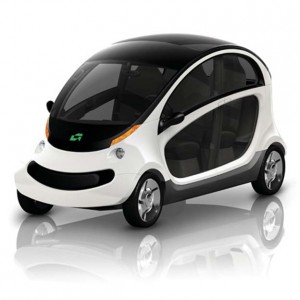
The GEM Peapod neighborhood-electrict vehicle is one of six products marketed by the former Chrysler subsidiary..
While there continues to be plenty of debate over the appeal of – and likely demand for – battery-electric vehicles like the Nissan Leaf and Chevrolet Volt, a new study suggests that sales of more limited Neighborhood Electric Vehicles, or NEVs, are charging up rapidly.
By 2017, forecasts Pike Research, there will likely be at least 695,000 of the golf cart-like vehicles, often referred to as low-speed electric vehicles, on global roadways. That’s up from 479,000 today. In the U.S., demand is expected to surge from 37,000 to 55,000 annually in that timeframe.
NEVS began to gain traction in the 1990s when the California Air Resources Board enacted short-lived rules aimed at forcing more zero-emissions vehicles on the road. The vehicles were permitted to sidestep many of the regulations, notably including safety guidelines for conventional automobiles, and most states have now approved them for use on roads where speed limits are lower than 35 mph. NEVs themselves can hit a maximum 25 mph.
They’ve become especially popular in gated communities, on college campuses and for use as security and utility vehicles, but a small number have also been sold to consumers who might alternatively opt for more limited scooters or even bicycles.
“Neighborhood electric vehicles are proof that EVs will take many forms in different parts of the world,” said Pike Research senior analyst Dave Hurst. “And while moderate in terms of sales volumes compared to other emerging vehicle markets, the growth rate for NEVs will double that of the total light duty vehicle market during the same period.”
The low price of the typical NEV is part of the appeal, usually running the equivalent of $100 to $200 per kilowatt hour of batteries. By comparison, the lithium-ion batteries on a vehicle like a Leaf or Volt can cost anywhere from around $500 to $1,000 per kilowatt hour.
Why the difference? Most NEVs rely on relatively old lead-acid technology, though makers have been developing more advanced flooded, gelled and absorbed glass mat variants that pack more power per pound than traditional lead-acid chemistries.
The Pike Research forecast may nonetheless generate some controversy. Many industry analysts have been taking an increasingly pessimistic view of battery power’s appeal. J.D. Power and Associates, for example, anticipated that all forms of electric vehicles will barely reach 7% of overall motor vehicle sales by 2020.
At least one big NEV player has exited the market in recent months. Chrysler decided to get out of the field, though it found a willing buyer for its GEM, or Global Electric Motors, division in Polaris Industries.
GEM has produced just 45,000 low-speed electrics since the company was founded in 1998. But Polaris officials expressed optimism that they can grow demand for the brand, which currently offers six different passenger and utility NEVs.
If the Pike study is correct, GEM could have a strong future.
